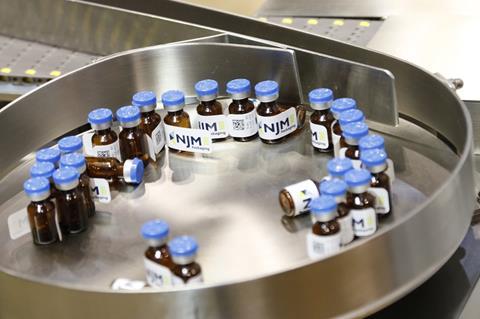
By Sean Riley, senior director, Media and Industry Communications, PMMI, The Association for Packaging and Processing Technologies
The global nutraceuticals market will continue to grow at a CAGR of 7.3 percent through 2021, according to Transparency Market Research. The sector was last valued at $182.6 billion in 2015 and, given these projections, will reach $278.95 billion within the next four years.
Much of this growth is due to the continuous strides made by the health-conscious consumer toward functional foods and beverages, dietary supplements and personal care. In the wake of nutraceutical market growth rides the implementation of provisions stemming from the Food Safety Modernisation Act (FSMA). To meet these regulations, nutraceutical companies will face various manufacturing challenges. In the near term, they can adjust to the burdens of these regulatory changes to capitalise on the opportunity presented by growing market demand.
In addition to regulatory challenges, growing consumer demand for clean label products, responsibly sourced ingredients, sustainable packaging and pressures to extend shelf life are factors that can pile on to the supply chain challenges of nutraceutical manufacturers. However, these companies can lean on suppliers to guide them in making the right packaging equipment and material selections to satisfy evolving consumer desires and keep their manufacturing operations efficient and profitable.

Regulatory Matters
Many food and beverage manufacturers have already taken measures to comply with the FSMA provisions applicable to their specific industries. Thanks to design modifications by packaging OEMs, these companies can continue to implement solutions that quicken sanitation processes. According to a 2016 Food Safety Modernization Update report by PMMI, The Association for Packaging and Processing Technologies, OEMs are seeking to improve sanitary designs, increase the use of stainless steel, reduce cleaning times from 30 minutes to five minutes and implement more tool-less designs in order to satisfy the FSMA requirements. For example, if a food and beverage manufacturer is producing a gluten-free and gluten containing product in the same facility, they must consider the cleanability needs to prevent cross-contamination. To reduce risks, nutraceutical companies should utilise good manufacturing practices (GMP) and designate hygienic zoning programs to differentiate between unprocessed and processed food locations.
Since the FSMA aims to foster more effective prevention of and planning for contamination instances, advanced track-and-trace mechanisms are also necessary for nutraceutical manufacturers to track issues and remove compromised product from shelves quickly. Data collection and IT improvements are also at the forefront of OEM equipment plans. New interfaces and Supervisory Control and Data Acquisition (SCADA) systems to facilitate efficient track-and-trace activities play an important role in the FSMA updates. Nutraceutical food and beverage processors are no exception to these trends and must collectively invest in these technologies in order to stay up to date. Companies can evaluate risks through monitoring, testing and archiving their safety procedures and then producing these journals to the Food and Drug Administration (FDA) to demonstrate that their manufacturing processes are clean and safe. An OEM’s attention to cleanability as well as the manufacturer’s ability to journal and demonstrate hygienic workspaces will help prevent regulatory matters from impeding operations for members of the nutraceutical manufacturing industry.
Clean Labels and Corporate Social Responsibility Work in Tandem
The consumer demand for clean label products continues to rise. In fact, 37 percent of U.S. consumers search for recognisable ingredients when making a purchase and reject ingredients that are unrecognisable. However, there is also a growing concern for corporate social responsibility (CSR), specifically how and where to procure ingredients for different nutraceutical products and functional foods. No nutraceutical manufacturer wants to source ingredients through means that consumers will find unpalatable. For example, when palm oil extraction accidents impacted wildlife and the environment, widespread coverage created an unfavorable image for brands that went against the wholesome, good-for-you product promises they offered.
With nutraceuticals being a key industry for consumers seeking health-giving and medicinally beneficial ingredients, nutraceutical manufacturers have to consider the source of these ingredients. If at all possible, sourcing non-GMO, gluten-free, natural and organic ingredients locally can also be an asset to a brand looking to entice health-driven consumers. In fact, according to PMMI’s 2017 Trends in Food Processing Operations report, one food processing leader cited, “the present value in America is knowing where our food ingredients come from; it requires tremendous transparency.”

Sustainable Packaging and Extending Shelf-Life
Coupled with the consumer demand for organisations demonstrating a strong sense of CSR is the need for sustainability and minimising the carbon footprint of a product. While new solutions for sustainable packaging are currently on the market, the challenge lies with how to properly extend shelf-life while still adhering to the consumer dislike for additives and preservatives. For example, recyclable, biodegradable and possibly paper-based pouches are often preferred. In fact, in PMMI’s 2016 Food Packaging Trends and Advances report 80 percent of food company leaders responded that they were interested in this type of sustainable packaging, but need assurance that they provide an appropriate level of barrier protection for perishables and acceptable shelf-life. On the other hand, flexible pouches afford opportunities for lightweighting, conserving space – and therefore fuel – in transportation along the supply chain while providing a wide range of barrier protections that prevent degradation from exposure to air, UV light and other contaminants.
Advancements in flexible packaging have even reinvigorated interest in existing technologies like High Pressure Processing (HPP), which can provide additive-free products like nutraceuticals a longer-shelf life. HPP is the practice of using very intense pressure in order to render pathogens ineffective in food and beverages, such as nutraceuticals and juices. One of the major benefits of using HPP for nutraceutical processors is its potential to extend the shelf-life by three to four times in some instances without using chemical additives. For instance, a healthy juice that would typically have a three-day shelf life can now extend to anywhere between nine and 12 days. Additionally, HPP protects the flavour properties of natural ingredients that the chemical additives and heat pasteurisation commonly used in processing can alter. To assist in the advancement of this technology and formalise industry best practices, PMMI convened the Cold Pressure Council (CP Council). The council will conduct an education session on the Innovation Stage at PACK EXPO Las Vegas 2017 (Sept. 25-27; Las Vegas Convention Center).
Nutrition for the Mind
Staying up-to-date with innovative technologies, consumer trends, regulatory matters and industry-wide challenges can be challenging while trying to remain competitive in a growing market. Nutraceuticals manufacturers and processors can benefit from a wealth of information and network with industry professionals at PACK EXPO Las Vegas 2017 and the co-located Healthcare Packaging EXPO. Both shows feature free education sessions open to all attendees including Innovation Stage, and the Reusables Learning Center. These sessions on new technology, industry specific innovations and best practices for sustainable supply chains are invaluable resources for nutraceutical professionals seeking to upgrade equipment or stay current with industry trends.
More info:

















